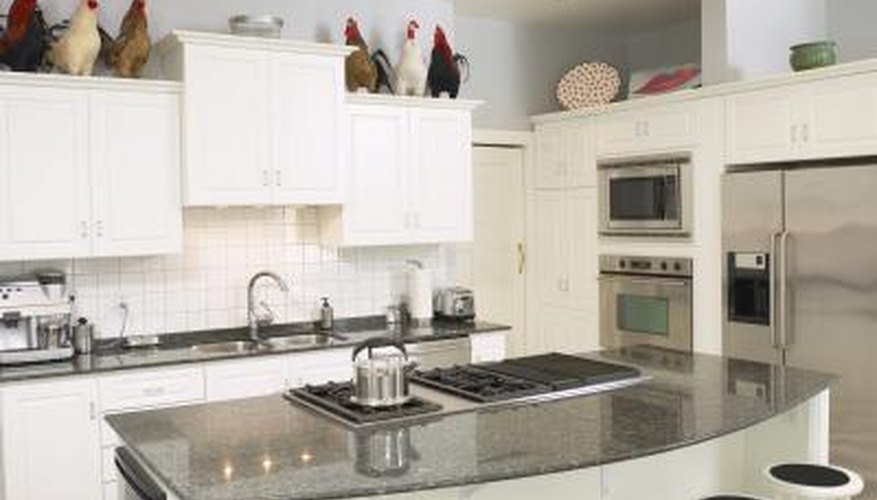Grease and grime can build up quickly on kitchen cabinets. The cooking you do every day sends grease to your cabinets, where it quickly sticks and becomes difficult to remove. Grease build-up makes your cabinets look and feel dirty. If they are made of natural wood, it takes away from the wood's beauty. If your cabinets are painted, a layer of grease gives an unappetizing look to your kitchen. There are several ways to attack the grease build-up problem on kitchen cabinets.
- Grease and grime can build up quickly on kitchen cabinets.
- The cooking you do every day sends grease to your cabinets, where it quickly sticks and becomes difficult to remove.
Clean your cabinets every time you cook. It's not much fun, but this is the best way to prevent grease build-up. New grease comes off easily, so don't allow it to build up over time. Simply wipe down the cabinets with a clean cloth after each cooking session and you'll get most of the grease.
Install a good outside vent. It will take much of the grease out of your kitchen when you cook. Many contractor-grade vents aren't strong enough to get all of the grease out, but the money you spend on professionally installing a good vent might be worth it when you consider the hours spent cleaning.
Save some money and avoid buying special cleaning products, especially if you attempt to prevent grease build-up by cleaning the cabinets on a fairly regular basis. Add 2 tablespoons of hand dishwashing soap to 2 cups of warm water. Apply with a clean cloth, following the natural grain of the wood. Rinse and dry with another clean cloth. Dishwashing soap contains chemicals that can break down grease.
- Install a good outside vent.
- Save some money and avoid buying special cleaning products, especially if you attempt to prevent grease build-up by cleaning the cabinets on a fairly regular basis.
Use commercial products if you only clean the cabinets once a year, since there will be a heavy build-up of grease. Many of these products have the word orange in their name. Always test them first in an inconspicuous spot to make sure they won't harm the wood. Once you're ready to clean, spray on the product and let it sit for a few minutes before rubbing with a clean cloth. If you're using a strong commercial cleaner, open the windows for some ventilation and wear a mask. Don't cook and clean at the same time. Many of the commercial products have a solvent base and can start a fire if used near a flame.
- Use commercial products if you only clean the cabinets once a year, since there will be a heavy build-up of grease.
Go green when you clean. Try a mixture of 3 tablespoons baking soda and 1 cup of water. Baking soda is mildly abrasive, but this method still will require a lot of elbow grease to get the job done right. You can also use a non-scratch sponge, but don't rub too hard. Rinse with clear, clean water. Then polish the cabinets with paste wax to help keep grease from penetrating the wood when you cook. Buff to a high shine with a clean lint-free cloth. White vinegar mixed with water and lemon juice mixed with water are other good environmentally friendly cleaners. Since these are non-toxic solutions, you can use them regularly to prevent build-up.
- Try a mixture of 3 tablespoons baking soda and 1 cup of water.
- Baking soda is mildly abrasive, but this method still will require a lot of elbow grease to get the job done right.
TIP
When removing the grease, clean a small area at a time and change cleaning rags frequently. You want to get rid of the grease, not move it around.
